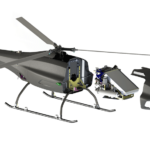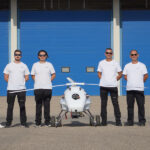9th August 2022
Recruitment in a wide range of positions adds to company’s drive towards solutions provider status; expansion into key civilian sectors takes shape as V-150 shows capacity to become platform of choice due to new updates on the way.
Europe’s leading provider of Rotary Unmanned Aerial Systems (UAS), UMS SKELDAR, is heavily increasing its recruitment drive in areas including flight operations, software engineering, training, and supply chain management to name a few as it ramps up its expansion in to key strategic civilian sectors. Alongside ongoing advancements to the V-200 and V-150 in terms of their key features and benefits, UMS is also rapidly increasing the amount of flight hours both platforms are performing on a weekly basis.

Over the last twelve months, the company has experienced impressive growth to almost 170 full-time employees across its facilities in Linköping, Sweden, Möhlin, Switzerland and in Benningen, Germany.
With further recruitment required in a wide variety of areas, UMS SKELDAR is expecting to add enough capacity to enable it to take advantage of the variety of tenders it is currently involved in.
Thanks to the SKELDAR V-150’s modular design and engine exchange system, an existing engine that has accumulated maximum service hours can be overhauled whilst a secondary engine is fitted in its place within just minutes. Another benefit is that routine system and engine maintenance can be performed far more efficiently, without the need for disassembly or removal of surrounding components. The ultimate aim is to enable end-users to carry out maintenance on the UAS quickly and cost-effectively, greatly increasing operational efficiency.




“The last 12 months have seen considerable changes being made to our organisation, most notably in terms of the recruitment strategy we are rolling out. We have done a lot of work reviewing the packages we now offer alongside the platforms. The mission requirements, including the concept of operations, platforms, maintenance procedures, training requirements, sensor operations, data analysis – basically the solution we provide to our customers – has been reviewed with our customers’ feedback in mind. Alongside strategic modifications to our key platforms, the next phase of our plan will see us expand into new markets.”

Axel Cavalli-Bjorkman,
UMS SKELDAR manufactures two rotary wing UASs, the SKELDAR V-200 and V-150. Both have seen increases in the amount of flight hours being conducted, thanks to a strategic move to fly in other locations across Europe.

“We are seeing a considerable interest from an increased amount of market sectors, which has given us a lot of insight into what we need to be able to offer in the future,” continues Cavalli-Bjorkman.
“With our V-150 platform for example, we have designed it with two payload bays to accommodate the need to use combinations of payloads. In addition, the real-time flight and mission management system has been developed to be particularly easy to use in all operating conditions and to support safe operations. Finally, the modular design of the V-150 enables a high degree of maintainability and minimum turn-around times during operations.”
More about Career at UMS SKELDAR
https://umsskeldarab.teamtailor.com/
More about V-200 Skeldar
https://umsskeldar.aero/v-200-skeldar/
More about V-150 Skeldar
https://umsskeldar.aero/v-150-skeldar/
This release has been issued on behalf of UMS SKELDAR by Kredo Consulting Ltd.
For further information please contact:
Andy Parker
andy@kredoconsulting.com
+44 1242 650573
Isabel Pedreira
isabel@kredoconsulting.com



